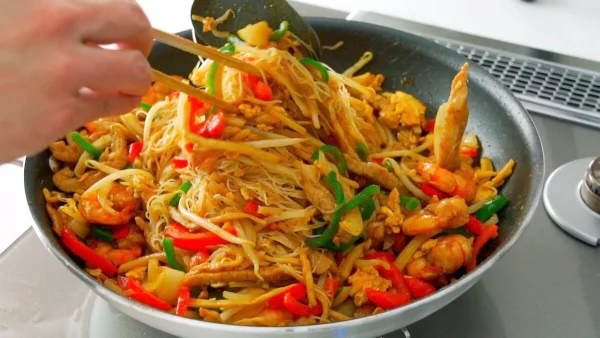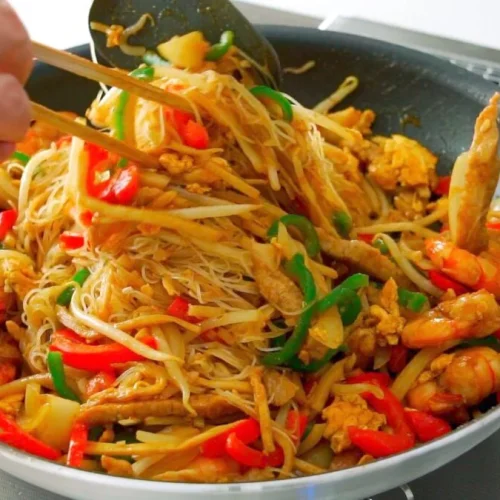
Singapore Noodles Recipe
Singapore Noodles is a vibrant, flavorful dish that’s both a feast for the eyes and the taste buds. Contrary to popular belief, this dish doesn’t originate from Singapore but is a staple of Chinese cuisine often found in Westernized Chinese restaurants. Its appeal lies in its delightful mix of thin rice noodles, colorful vegetables, savory proteins, and aromatic spices, with curry powder lending its signature golden hue and depth of flavor.
Whether you’re hosting a dinner party or preparing a quick weeknight meal, Singapore Noodles is a versatile option that’s easy to customize. Let’s dive into its history, ingredients, and a step-by-step guide to recreating this classic dish in your kitchen.
A Brief History of Singapore Noodles Recipe:
Despite the name, Singapore Noodles is not traditionally Singaporean. Its origins are traced back to Cantonese chefs in Hong Kong who sought to create an innovative dish that would appeal to international diners. By combining the distinct flavors of curry powder with stir-fried rice noodles, these chefs invented a recipe that quickly gained popularity worldwide. Today, it’s celebrated as a fusion dish, symbolizing the adaptability of Chinese cuisine to local tastes and global influences.

Singapore Noodles Recipe
Equipment
- Large wok or frying pan
- Mixing bowls
- Tongs or spatula
Ingredients
Vegetables:
- Red bell pepper, thinly sliced – 1
- Green bell pepper, thinly sliced – 1
- Carrot, julienned – 1
- Green onions, chopped – 2 stalks
- Yellow onion, thinly sliced – 1 small
- Eggs: 2, lightly beaten
- Curry powder: 2 tablespoons
- Garlic: 2 cloves, minced
- Ginger: 1 teaspoon, grated
- Soy sauce: 2 tablespoons
- Sesame oil: 1 tablespoon
- Vegetable oil: 2 tablespoons
- Salt and pepper: To taste
- Optional garnish: Fresh cilantro and lime wedges
Instructions
- Prepare the Rice Noodles:Soak the rice noodles in warm water for about 8–10 minutes, or according to the package instructions. Once softened, drain and set aside.
- Cook the Eggs:Heat 1 tablespoon of vegetable oil in a large wok over medium heat. Pour in the beaten eggs, scrambling gently until fully cooked. Remove and set aside.
- Cook the Protein:In the same wok, heat another tablespoon of vegetable oil. Add your chosen protein (shrimp, chicken, tofu, or pork) and stir-fry until fully cooked. Remove and set aside.
- Sauté the Aromatics:Add sesame oil to the wok. Toss in the minced garlic, grated ginger, and sliced onion. Stir-fry until fragrant, about 1 minute.
- Add the Vegetables:Increase the heat slightly and add the bell peppers, carrots, and green onions. Stir-fry for 2–3 minutes until they’re slightly tender but still crisp.
- Season and Combine:Sprinkle curry powder over the vegetables and stir well to coat. Add soy sauce, cooked noodles, eggs, and protein back into the wok. Toss everything together using tongs or a spatula until the noodles are evenly coated and heated through.
- Final Touches:Season with salt and pepper to taste. Garnish with fresh cilantro and serve with lime wedges on the side for an extra burst of flavor.
Video
Similar Recipes You’ll Love:
Pad Thai: A Thai noodle stir-fry featuring tamarind sauce, peanuts, and a medley of proteins and vegetables.
Chow Mein: A classic Chinese dish with stir-fried noodles, soy-based sauce, and your choice of protein.
Vegetable Lo Mein: A vegetarian-friendly option with hearty noodles and a savory sauce.
Hakka Noodles: An Indo-Chinese favorite with spicy, tangy flavors and a mix of colorful vegetables.
Thai Drunken Noodles: Bold and spicy, these noodles are a perfect comfort food.
Frequently Asked Questions About Singapore Noodles Recipe:
1. Is Singapore Noodles spicy?
It has a mild to medium spice level from curry powder, but you can adjust it by using more or less curry or adding chili.
2. Can I make it vegetarian or vegan?
Absolutely! Use tofu or extra vegetables as a protein substitute and opt for vegan curry powder and soy sauce.
3. What’s the best type of noodles to use?
Thin rice vermicelli works best as it absorbs the flavors while maintaining its texture.
4. How can I store leftovers?
Store in an airtight container in the refrigerator for up to 3 days. Reheat in a pan to restore its texture.
5. Can I freeze Singapore Noodles?
While possible, freezing can alter the texture of the noodles. It’s best enjoyed fresh or refrigerated for short-term storage.
6. What protein works best?
Shrimp, chicken, and tofu are popular choices. Feel free to mix and match according to your preference.
7. Can I make it gluten-free?
Yes, use gluten-free soy sauce or tamari, and ensure your curry powder is gluten-free.
8. What can I serve with Singapore Noodles?
Pair with spring rolls, dumplings, or a simple cucumber salad for a complete meal.
9. Can I use other vegetables?
Definitely! Snow peas, broccoli, mushrooms, and bean sprouts are great additions.
10. What if I don’t have a wok?
A large, deep frying pan works just as well. Just ensure it’s big enough for tossing the noodles and ingredients.
Conclusion:
Singapore Noodles is a delightful dish that captures the essence of global culinary fusion. Easy to make and endlessly customizable, it’s a recipe that can cater to diverse tastes and preferences. Whether you’re a seasoned chef or a home cook, this dish is sure to bring vibrant flavors and colors to your table. Give it a try and discover why it’s a favorite worldwide!
YouTube Video Credits:
Souped Up Recipes

Leave a Reply